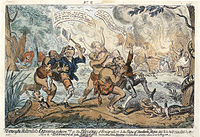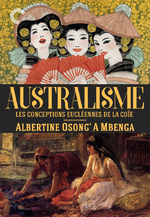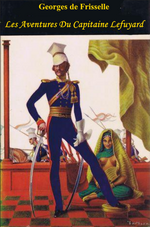Roman austral

The Roman austral, in Estmerish Austral Novel, was a genre of literature which arose in colonial era Euclea, particularly Gaullica which is regarded as the birthplace of the genre. As a genre, the Roman austral was centred on often exoticised stories depicting Coian cultures and wildlife, with the protagonists invariably being white Euclean adventurers. Such stories focused primarily on excitement and instilling a desire for colonial adventure among the Euclean populations, sacrificing realistic portrayal of cultures and peoples in favour of ones which would inspire Euclean imaginations.
The first Roman austral is generally considered to be Renée Daumec's 1830 work Au cour du roi des pygmées, which was set within the jungles of the Masamongo in modern day Mabifia. While Bahia was the dominant setting for such novels, given its perceived "primitiveness" compared to Euclea, such novels also explored Satria, the Great Steppe, and on occasion even southern and southeastern Coius. The genre reached its high point during the late 19th century, as the Fatougole saw the rapid annexation of much of Bahia, before waning in popularity through the efforts of the Euclean Society of Austral and Oriental Anthropology and development of native Coian literature in Euclean languages which challenged the image painted by the pro-colonial Romanciers australs. In modern literary criticism, the genre is seen in a mostly negative light due to its role in the advancement of colonialism.
History
The first novel to be classified as a roman austral was Au cour du roi des pygmées (At the Court of the Pygmy King) which was written by Renée Daumec in 1808. While Daumec had never visited Bahia, he had heard stories about the subcontinent while working at the port of Maredoux which he used as inspiration for the story. Despite this lack of genuine knowledge about Bahia, this novel was touted as being based off true stories and was a major success. While tales of strange foreign lands had always been a staple of folklore and literary culture in Euclea, the expansion of print media and literacy during the 19th century had created a desire for stories which could entertain a working class audience tired of long-winded poetry and philosophy. This coincided with the expansion of colonialism by Euclean powers, which had exposed the common people of these states to Coian culture through the arrival of new products on the markets, the presence of people of different skin colours due to both slavery and indentured labourers, and the display of rich treasures and handicrafts taken from colonial possessions. These inspired the imaginations of many people living in Euclea, providing a sort of colourful escape from the mundane reality of life following the industrial revolution. Au cour du roi des pygmées had a simple plot; a Gaullican soldier travelled to Bahia in search of treasure, braved numerous hazards, and achieved prosperity beyond his wildest dreams. This appealed to its audience, who were enraptured by Daumec's depictions of cannibal tribes and wild beasts such as Hippopotami. Following this book's success, Daumec would write several other stories set in Bahia, each one attaining significant popularity.
The success of Au cour du roi des pygmées attracted the attention of other writers, who saw the interest in "exotic" cultures and adventures. Similar stories were soon written by other authors, who saw their own financial successes. Much like Daumec, these authors had no lived experience with Bahian culture and based their depictions on second or even third-hand reports of life in the subcontinent. This growing obsession with stories set in Bahia caught the attention of the Gaullican Colonial Office, who saw the value of influencing public opinion on Bahia and growing popular support for colonial efforts. A publishing house was established by the Masson family, descendents of the Gaullican explorer and colonial administrator Michel Masson, named Editions Masson, which worked in conjunction with the colonial office to publish books which featured negative depictions of Bahian cultures in a way which would give credence and support to missionary work by the Solarian Catholic Church. With the support of the colonial office, the genre also branched out to other subcontinents of Coius, with Honoré de Couillesac's Aventures mirables dans le pays des gourous (Marvelous Adventures in the Land of Gurus) set in Satria and portraying the region in a negative light. While the stories themselves changed, the themes of racial, cultural and religious supremacy of Eucleans were omnipresent, often involving misleading or completely incorrect depictions of Coian cultures.
While the genre started in Gaullica, its success swiftly spread to other Euclean nations involved in colonisation. A translation of La Periple d'Alain Brasset, caporal gaullois, aux forets sauvages baïens (The Periple of Alain Brasset, a Gaullican corporal, in the savage bahian forests) into Estmerish sold thousands of copies and led to a frenzy of similar works being published in Estmere. The simple and universal appeal of such fiction to the general populace of Euclea was such that newspapers began serial austral novels in order to gain readership. In Etruria, where Bahian colonialism was less present, Romanciers australs focused upon Satria. Here, unlike in other countries where the depiction of native cultures was almost entirely negative, there was a strong tendency to separate between the urbanised Satrians and Vanavasi. While the urbanised Satrians were often described as violent, manipulative and cruel, the Vanavasi attained the status of noble savages due to their peaceful and natural lifestyles. It is believed that this was due to the prevalence of pre-Sotirian Solarian beliefs within Etrurian folklore, as the Vanavasi were seen to be similar to satyrs in their livelihoods.
The genre reached its apogee during the 1840s, coinciding with the high point of Euclean colonial expansion in Bahia and the defeat of Kambou, the most powerful of the remaining Houregic states. In the years that followed, stories from the colonies remained popular, often focusing on sensationalised accounts of Bahian Secret Societies and the wildlife of Coius. Interest in the genre remained steady, peaking again with the Sougoulie. However, from the 1840s, Romans australs faced opposition from the Euclean Society of Austral and Oriental Anthropology. This society, which united academics from across the continent, aimed to preserve and research the cultures of the colonies and saw such inaccurate hearsay depictions of Coian cultures to be counterproductive to this goal. They published refutations of many popular novels, promoting ethnographic studies of such cultures instead. The development of native literature in colonial languages also damaged the literary credentials of the Austral Novel, as works such as L'aube sur la brousse by Pierre-Michel Diallo painted vastly different pictures of both pre-colonial and post-colonial life in Bahia. Despite this, the Roman austral remained relatively popular right up until the postGreat War era, when popular opinion of colonialism waned and Coian countries began to gain independence. The Roman austral was heavily criticised by many Aïibe ka Djâmanou authors, as well as Coian philosophers, who saw it as having undermined native voices and been a key part of colonial rhetoric.
Tropes
Several tropes feature prominently within the Roman austral genre. These are commonly-repeated motifs, such as certain character archetypes, which became almost synonymous with the genre. Some of these tropes include:
- The main character was invariably a white man, often a soldier of fortune, who represented the colonial ideal. He was a competent man, able to complete any task put to him, fearless in the face of danger, devoted to his country. The main variations on this character, aside from country of origin, came in his attitude towards women and family life. While many of the earlier protagonists were womanisers, representing a sort of male fantasy, the influence of the Solarian Catholic Church and colonial office over the genre soon replaced this with an emphasis on strong family values.
- Characters of black skin were almost always unintelligent, violent, and simplistic, easily manipulated though not cruel. Some stories carried messages of paternalism, implying that Bahians could be taught civilised Euclean mores, while others pushed a narrative that suggested such races were only fit for slavery. "Brown peoples", as Rahelians, Satrians and Pardarians were classified, were usually cunning yet cruel and cowardly; the peoples of southern and southeastern Coius were generally depicted either as savages useful only for menial labor and violence, or as decadent and amoral pleasure-seekers. The main deviations from this pattern were the Mirites, whose Sotirian faith marked them as different and palatable to a Euclean audience, and the Vanavasi, whose peaceful and naturalistic lifestyle inspired the imaginations of Etrurian writers.
- Bahian Fetishism was commonly depicted, always in a negative manner. A common villain was the witch doctor, a figure based upon the nyanga of Rwizikuru, while stories of Sotirian missionary workers and converts being persecuted were commonplace. The depictions of Fetishism and Fetishist rituals were based on accounts from outsiders, and therefore lacked any nuance or real understanding of the practices.
- Cannibalism, while a relatively rare practice in Bahia, played a key role in many stories due to its shock value to Euclean audiences.
- The wealth of the colonies played a major plot role in most stories.
Legacy

The role played by the Roman austral in the popularisation of colonisation in Euclea was significant. It made the key arguments for the venture, namely racial supremacy, potential for economic exploitation, Sotirian missionary duties, and masculine ideals of exploration and adventure, readily available to the populace of Euclea in a way that dry academic works never could. By creating popular heroes of the soldiers involved in colonialism, the Roman austral was able to inspire people to enlist in the armies of Euclean states in order to seek out their own colonial adventures. It also perpetuated a wide range of stereotypes and racial attitudes towards Coian peoples, which would remain influential in the popular conscience for a long time. Many of the caricatures which were popularised by the genre are mainstays of contemporary Euclean anti-Bahian and anti-Satrian racism, while the picture of Bahian Fetishism painted in such novels is still widespread due to the lack of exposure to accurate information about the belief system.
In her seminal work Australisme, Mabifian-Gaullican author Albertine Osong' A Mbenga explored the importance of the Roman austral's oversized influence on Coian literature, in particular its creation of a narrative which pushed native authentic lived experience to the side in favour of a created idea of what Coius was. Native authors, according to Osong' A Mbenga's theory, had to first reclaim their own voice when writing before even attempting to dispel the illusions of Coian life which had been implanted by the genre's success. Much early native Coian literature was therefore highly ethnographic in its content, with the autobiography being a key tool of literary resistance as evidenced by works such as Ibrahim Barkindo's Mon père avait douze bovins which dealt with the influences of colonialisation on traditional Ndjarendie culture. While the efforts of such authors, combined with those of the Euclean Society of Austro-Oriental Anthropology, helped to combat the intellectual influence of the Austral novel, Osong' A Mbenga argues that its creation of caricatured tropes for Coian cultures has kept native Coian scholarship on the back foot as they have constantly needed to deconstruct created perceptions which exotify or savagify the mundane reality of life in Coius.
Beginning in 1968, the Gaullican author Georges de Frisselle published the first novel of the Adventures of Captain Lefuyard series, presented as newly discovered memoirs. Widely considered to be a satirization of Roman austral, it features the travels of the eponymous character across Bahia, Satria, and the Asterias and his involvement in major historical events during the early to late 19th century. The series inverses the traditional tropes of the genre; Captain Lefuyard is portrayed as an amoral and cowardly bully who usually tries to flee whenever he faces adversity. Nevertheless, through a combination of luck, cunning, and his high social status, he is usually acclaimed as a hero at the end of each novel. Unlike the genre it satirises, it avoids traditional stereotypes and tropes in favor of a more realistic portrayal of native peoples based upon ethnographic work. Lefuyard's active participation in Gaullican colonization and his complete indifference to its effects on the native population, is one of the defining aspects of the series. In particular he is an insatiable lecher, especially for native women regardless of their martial status and Lefuyard's own marriage. At the time of its publication, the series was controversial for its sexual content and its depiction of the effects of Euclean colonial policies, although the novels were popular and sold well. In total over 9 novels were written and are widely considered to be one of the best examples of satire, although it continues to be controversial for its content, especially for its portrayal of women, particularly non-Euclean ones.
With the rise of political correctness in Euclea and the decreasing acceptability of racism, many Austral novels which were previously regarded as must-read literary classics have been re-evalued and criticised. An example of this are the "Algernon Stanley" novels, a series of childrens novels centred upon Estmerish captain Algernon Stanley and his adventures in the Estmerish Empire. The books feature racist depictions of Sivathrans and involve slavery in the Magadi. In 2010, following public outcry, many school libraries in Estmere removed the books from their shelves, though this was criticised by some conservative groups as "erasing history". The teaching of such novels is a contentious political issue in Euclea, and many modern prints now include disclaimers about the sensitive nature of their content.
